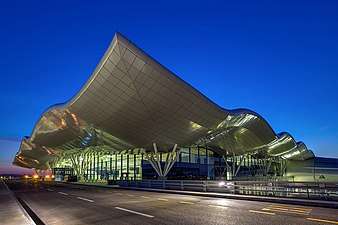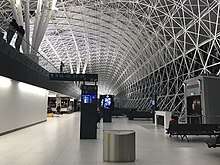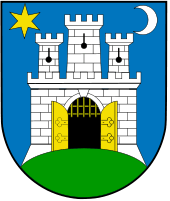Zagreb Airport
Zagreb Airport Franjo Tuđman (IATA: ZAG, ICAO: LDZA) is the largest and busiest international airport in Croatia. In 2019 it handled 3.45 million passengers and some 13,000 tons of cargo.
Franjo Tuđman Airport Zagreb Međunarodna zračna luka Franjo Tuđman Zagreb | |||||||||||||||
|---|---|---|---|---|---|---|---|---|---|---|---|---|---|---|---|
 | |||||||||||||||
 | |||||||||||||||
| Summary | |||||||||||||||
| Airport type | Public/Military | ||||||||||||||
| Operator | MZLZ d.d. (Groupe ADP) | ||||||||||||||
| Serves | Zagreb, Croatia | ||||||||||||||
| Location | Velika Gorica | ||||||||||||||
| Hub for | |||||||||||||||
| Elevation AMSL | 353 ft / 108 m | ||||||||||||||
| Coordinates | 45°44′35″N 016°04′08″E | ||||||||||||||
| Website | zagreb-airport.hr zag.aero | ||||||||||||||
| Map | |||||||||||||||
 LDZA Location in Croatia | |||||||||||||||
| Runways | |||||||||||||||
| |||||||||||||||
| Statistics (2019) | |||||||||||||||
| |||||||||||||||
Named after Franjo Tuđman, the first President of Croatia, the airport is located some 10 km (6.2 mi) southeast of Zagreb Central Station[4] in Velika Gorica. It is the hub of the Croatian flag carrier Croatia Airlines and a focus city for Trade Air. The main base of the Croatian Air Force is also located at the airport's premises. Moreover, the Croatian Air Traffic Control has its administratration situated on the grounds of the airport.
The airport was awarded to the ZAIC consortium (Zagreb Airport International Company) in a 30-year concession under the terms of a contract signed by the Government of Croatia with the aforementioned. The contract includes the financing, designing and construction of a new passenger terminal which was opened in March 2017. For the purpose of managing the airport ZAIC registered a company called MZLZ d.d. (Međunarodna zračna luka Zagreb d.d.) that is now the operator of the Airport.
History
The history of Zagreb civil aviation began in 1909 when the first airfield was built close to the western city neighborhood (city district) of Črnomerec.
With the creation of the first Yugoslav flag carrier Aeroput in 1927, the airport was relocated to the Borongaj airfield in 1928 which began serving the ever-growing number of passengers on 15 February of that year. Although several European airliners connected the city it was mostly Aeroput which connected Zagreb to major destinations across Europe and thus significantly increased traffic at Zagreb in the period preceding the Second World War.
Following World War II, commercial services were moved to a former military airbase near the village of Lučko south-west of the city in 1947. JAT Yugoslav Airlines took the role of Aeroput and made Zagreb its second hub. At its peak in 1959, Lučko served 167,000 passengers.

The current location of the airport at Pleso in the south-east of Lučko opened in 1962 with a 2,500 m (8,200 ft) long runway and 1,000 m2 (11,000 sq ft) terminal. By 1966, Zagreb Airport got a new 5,000 m2 (54,000 sq ft) state-of-the-art passenger terminal. The runway capacity was lengthened to its current 3,252 m (10,669 ft) in 1974.
In the 1980s, Zagreb Airport was the second largest in Yugoslavia by passenger and aircraft movements. Yugoslav flag-carrier JAT maintained a hub in Zagreb and connected the city to numerous destinations including New York, Chicago, Toronto which inevitably had a major impact on air traffic at Zagreb during that period.
Following an increase in passenger numbers and the necessity to upgrade its infrastructure, the airport installed a CAT-IIIb instrument landing system (ILS) in 2004.
In 2008, a new VIP terminal was added and the terminal extended for extra amenities, restaurants and bars. The terminal was expanded to 15,500 m2 (167,000 sq ft)[5]
By 2010, the old terminal has been nearing its maximum annual capacity. That year the passenger terminal received a major facelift in the course of which a viewing platform with a bar was added.
On 12 April 2012, the ZAIC (Groupe ADP) consortium received a 30-year concession for the airport from the Government of Croatia. The concession includes financing, designing and constructing a new passenger terminal. The construction of a brand new 70,000 m2 (750,000 sq ft) terminal facility designed by Neidhardt architects of Zagreb and carried out by Bouygues Bâtiment International in partnership with Viadukt began on 18 December 2013 with the aim to replace the old terminal. It now has an initial annual capacity of 5.5 million passengers in the first phase and was officially completed in October 2016. The official inauguration of the terminal was on 28 March 2017. ZAIC now operates the entire airport for 30 years including the runways, the current passenger terminal, the cargo terminal, car parks and all future property developments. The concession contract involves a total investment of around €324m (£259m): €236 million for the design and construction of the new terminal and €88 million for operation of all airport infrastructure for the entire period of the concession.[6]
On 27 February 2020, the runway, formerly designated as 05/23, was redesignated to 04/22 due to the change in magnetic declination.[7]
Terminal

The current terminal building was opened to the public on 28 March 2017.[8] It stretches over 65,800 m2 (708,000 sq ft) on three levels featuring three baggage carousels, 8 air bridges, 9 security checkpoints, 30 check-in desks, 23 passport control booths and a car park with the capacity of 1,100 vehicles. Furthermore, the new apron has three remote stands next to the terminal, while 23 stands at the old passenger building are also used during the peak season. Each of the aircraft parking positions at the facility includes a visual docking guidance system which gives information to a pilot on how to park their aircraft. The terminal itself features a large 600 square metre duty-free shop operated by Aelia, 16 cafés, bars, restaurants and snack bars.
Enough space has been left for 30 additional check-in counters and 2 baggage carousels to be added once the new terminal reaches its current maximum capacity of 5 million passengers. Further extensions envisaged along the thirty-year concession period will potentially see expanding current apron from present 100,000 to 300,000 m2 (1,100,000 to 3,200,000 sq ft) and terminal capacity increased to 8 million through gradual expansion of the terminal in four Phase 2 expansions.[9][10][11]
Airlines and destinations
Passenger
Cargo
| Airlines | Destinations |
|---|---|
| DHL Aviation | Bergamo, Bologna, Cologne/Bonn, Leipzig, Ostrava, Venice |
| MNG Airlines | Istanbul–Atatürk, Paris–Charles de Gaulle |
| Qatar Airways Cargo | Doha |
Ground transportation
Statistics
Traffic
| Year | Passengers | Passenger % Change |
Aircraft Movements | Aircraft Movements% Change |
Cargo (tonnes) | Cargo % Change |
|---|---|---|---|---|---|---|
| 2000 | 1,149,830 | n/a | n/a | n/a | 7,388 | n/a |
| 2001 | 1,185,471 | 3.10 |
n/a | n/a | 7,791 | 5.45 |
| 2002 | 1,203,436 | 1.52 |
n/a | n/a | 7,347 | 5.70 |
| 2003 | 1,314,652 | 9.24 |
n/a | n/a | 8,608 | 17.16 |
| 2004 | 1,408,206 | 7.12 |
n/a | n/a | 8,899 | 3.38 |
| 2005 | 1,551,519 | 10.18 |
37,484 | n/a | 12,492 | 40.38 |
| 2006 | 1,728,414 | 11.40 |
40,884 | 9.07 |
10,393 | 16.80 |
| 2007 | 1,992,455 | 15.28 |
43,250 | 5.79 |
12,564 | 20.89 |
| 2008 | 2,192,453 | 10.04 |
44,542 | 2.99 |
12,697 | 1.06 |
| 2009 | 2,062,242 | 5.94 |
40,684 | 8.66 |
10,065 | 20.73 |
| 2010 | 2,071,561 | 0.45 |
39,812 | 2.14 |
8,156 | 18.97 |
| 2011 | 2,319,098 | 11.95 |
42,360 | 6.40 |
8,012 | 1.77 |
| 2012 | 2,342,309 | 1.00 |
39,084 | 7.80 |
8,133 | 1.51 |
| 2013 | 2,300,231 | 1.80 |
36,874 | 5.58 |
7,699 | 5.34 |
| 2014 | 2,430,971 | 5.68 |
38,348 | 4.00 |
8,855 | 15.01 |
| 2015 | 2,587,798 | 6.45 |
39,854 | 3.93 |
9,225 | 4.18 |
| 2016 | 2,766,087 | 6.89 |
40,796 | 2.36 |
10,074 | 9.20 |
| 2017 | 3,092,047 | 11.78 |
41,585 | 1.93 |
11,719 | 11.75 |
| 2018 | 3,336,310 | 7.89 |
43,688 | 5,06 |
13,676 | 16.71 |
| 2019 | 3,435,531 | 2.9 |
45,061 | 3,14 |
12,881 | 5,8 |
| Month | Passengers 2019 | Passengers 2020 | Passenger % Change |
Aircraft Movements 2019 | Aircraft Movements 2020 | Aircraft Movements % Change |
Cargo (tonnes) 2019 | Cargo (tonnes) 2020 | Cargo % Change |
|---|---|---|---|---|---|---|---|---|---|
| January | 191,197 | 203,035 | 6,2 |
3,045 | 3,133 | 2,9 |
871 | 910 | 4,5 |
| February | 181.154 | 184.236 | 1,7 |
2.826 | 2.994 | 5,9 |
805 | 772 | 4,1 |
| March | 232.978 | 97.063 | 58,34 |
3.356 | 2.310 | 31,17 |
957 | 829 | 13,37 |
| April | 280,790 | 5.118 | 98,18 |
3,776 | 365 | 90,33 |
1.091 | 1.012 | 7,24 |
| May | 311,368 | 13,881 | 95,54 |
4,283 | 572 | 86,64 |
1,389 | 673 | 51,54 |
| June | 336,618 | 44,402 | 86,81 |
4,088 | 1,138 | 72,16 |
1,129 | ||
| July | 366,242 | 4.356 | 1.159 | ||||||
| August | 376.026 | 4.401 | 1.022 | ||||||
| September | 350,138 | 4.190 | 1.050 | ||||||
| October | 330.598 | 4.045 | 1.245 | ||||||
| November | 247.277 | 3.344 | 1.123 | ||||||
| December | 231.145 | 3.351 | 1.040 |
Busiest airlines
| Rank | Carrier | Passengers 2019 | Passengers % | |
|---|---|---|---|---|
| 1 | Croatia Airlines | 1,608,502 | 52.00 | |
| 2 | Lufthansa | 253,843 | 8.21 | |
| 3 | Turkish Airlines | 141,844 | 4.35 | |
| 4 | Eurowings | 135,720 | 4.30 | |
| 5 | Qatar Airways | 127,218 | 4.2 | |
| 6 | Austrian Airlines | 105,525 | 3.29 | |
| 7 | Emirates | 98,442 | 3.18 | |
| 8 | British Airways | 71,347 | 2.31 | |
| 9 | KLM | 58,435 | 1.89 | |
| 10 | Air France | 58,240 | 1.88 | |
| - | All others | 442,119 | 14.00 | |
| Source: Zagreb Airport[23] | ||||
| Rank | Destination | Departing passengers | Operating airlines | |
|---|---|---|---|---|
| 1 | Frankfurt Airport | 321,907 | Croatia Airlines, Lufthansa | |
| 2 | Dubrovnik Airport | 268,173 | Croatia Airlines | |
| 3 | Split Airport | 201,065 | Croatia Airlines | |
| 4 | Munich | 191,990 | Croatia Airlines, Lufthansa | |
| 5 | Amsterdam | 167,469 | Croatia Airlines, KLM | |
| 6 | London–Heathrow | 164,426 | British Airways, Croatia Airlines | |
| 7 | Vienna | 164,108 | Austrian Airlines, Croatia Airlines | |
| 8 | Paris–Charles de Gaulle | 151,505 | Air France, Croatia Airlines | |
| 9 | Istanbul–Atatürk | 141,844 | Turkish Airlines | |
| 10 | Hamad International Airport | 127,218 | Qatar Airlines | |
| Source: Zagreb Airport[23] | ||||
References
- Bohtinski, Josip (24 June 2017). "Sedam zračnih luka zaradilo je lani čak 215,5 milijuna kuna". Večernji list (in Croatian). Retrieved 21 August 2018.
- "ZRAČNA LUKA ZAGREB, d.o.o." prosjecna-placa.info. Archived from the original on 28 April 2018. Retrieved 21 August 2018.
- "Međunarodna zračna luka Zagreb d.d." prosjecna-placa.info. Archived from the original on 28 April 2018. Retrieved 21 August 2018.
- "EUROCONTROL – The European AIS Database: Introduction to EAD Basic – Home". Retrieved 3 June 2015.
- "Međunarodna zračna luka Zagreb – Zagreb International Airport – Naslovna". Archived from the original on 8 April 2015. Retrieved 3 June 2015.
- Vlada Republika Hrvatska Potpisan Ugovor O Koncesiji za izgradnju Archived 1 July 2012 at the Wayback Machine (In Croatian) 11 April 2012
- "New marking and signage on the Franjo Tudjman airport". avioradar.hr. Retrieved 1 August 2020.
- http://hrcak.srce.hr/file/126124
- "Nešto o pregovorima s Francuzima, Nizozemskoj bolesti i gospodinu Petitu, bacanju papira i vremenu od travnja 2012. godine do prosinca 2013. godine. - Siniša Hajdaš Dončić". Siniša Hajdaš Dončić (in Croatian). 18 March 2017. Retrieved 21 August 2018.
- "Grand opening of the new passenger terminal of Franjo Tuđman Airport". Zagreb Airport. Retrieved 21 August 2018.
- "Zagreb International Airport's New Terminal - Airport Technology". Airport Technology. Retrieved 21 August 2018.
- "Air Canada Expands its Global Network". Air Canada. Retrieved 28 September 2017.
- "Emirates and flydubai come together to offer customers seamless travel options to Zagreb this winter". emirates.com. Retrieved 23 July 2018.
- "Emirates resumes flights to Zagreb for summer season". arabianbusiness.com. Retrieved 23 April 2019.
- "Korean Air S20 Europe/Russia service changes as of 14NOV19". Routesonline. 14 November 2019. Retrieved 14 November 2019.
- "Korean Air S20 Europe / Russia Network adjustment as of 13MAY20". Routesonline. 14 November 2019. Retrieved 14 May 2020.
- http://www.trade-air.com/
- "Thai AirAsia X Schedules Airbus A330 Charter Flights To Croatia". Simple Flying. 30 March 2020. Retrieved 30 March 2020.
- "Tunisair resumes Monastir – Zagreb charter in S20". Routesonline. 20 January 2020. Retrieved 20 January 2020.
- "How to get from Zagreb Airport". Retrieved 15 March 2018.
- "Pleso Prijevoz timetable". Pleso prijevoz. Retrieved 22 January 2020.
- "Statistics – Naslovna". MZLZ. Retrieved 3 March 2019.
- "Međunarodna zračna luka Zagreb | Zagreb International Airport – Naslovna". Zagreb-airport.hr. Retrieved 20 May 2016.
External links
![]()
- Official website of operator
- Accident history for ZAG at Aviation Safety Network
- Šeb, Zvonko, ed. (2012). Zagreb Airport – 50 years (in English and Croatian). Zagreb Airport. Archived from the original on 10 April 2014.CS1 maint: ref=harv (link)
